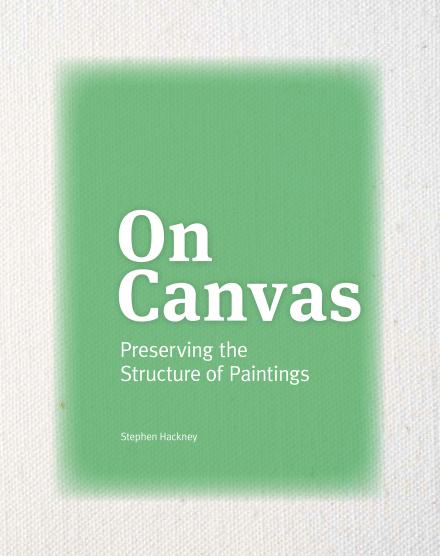Book Review: On Canvas
Submitted by sharragrow on Wed, 09/12/2020 - 16:31

Review by Joyce Townsend
On Canvas: Preserving the Structure of Paintings
By Stephen Hackney
The Getty Conservation Institute, 2020
256 pages / $50 Getty Store / £40 Amazon / Paperback
ISBN: 978-1-60606-626-3
On Canvas is very much the book of a lifetime’s experience, recollected in the tranquillity of not working to deadlines in a busy studio. Its author worked in one institution as a painting conservator, conservation scientist and manager for nearly four decades. His long-term research into the deterioration of canvas and appropriate preventive measures to slow the progress of change is captured here, illuminated by decades of practice in the conservation of paintings on canvas.
It is illustrated with many examples from the Tate collection which he knew so well, often later 19th-century and 20th-century examples, because paintings of that age are today perceived as requiring treatment to their weakening canvas for the first time. That first treatment narrows the choices for all later conservators, and they must cope with its consequences. The artist’s use of canvas is not neglected in this book, but the main focus is on how restorers have treated canvas in the past, and what conservators should do (and should not do) with it now to extend its survival and reduce the need for interventive treatments such as lining that were once carried out automatically on canvases no more than a few decades old. Lining, as a process, was scarcely questioned until 1974 when the significant conference held at Greenwich, London, discussed its disadvantages as well as improvements in its practice. That event would lead to very active studies into the properties and ageing of canvas for the rest of the twentieth century. Stephen Hackney and his long-term collaborators in the USA and Canada, as well as the UK, carried out much of that research which was widely published and influential. Today these print-only conference proceedings can be difficult of access, so the knowledge shared during them was in danger of being forgotten as participants in such research retired or were never fully utilised by their successors. It is good that such studies are reviewed and usefully summarised in On Canvas, with their implications interpreted to a greater degree than they often were in the original publications.
The book, like Caesar’s Gaul, is divided into three parts. The first covers past uses of canvas, artists’ more recent uses and choices of material, what canvas can be made from and the history of use of treatments such as lining and marouflage that younger conservators will never have witnessed being carried out, though they frequently encounter older paintings that have undergone such treatments more than once. From the mid-twentieth century, not all canvases have been stretched, two-dimensional, rectangular, primed at all, painted all over, or even free of intentional cuts and holes. Lining has ceased to be an option anyway, for non-traditional works that include canvas. Today a never-lined painting is often valued as a better representation of the artist’s intention than a repeatedly treated one, and every effort is made to ensure that it remains unlined. Treatments have become more object-specific, less generic than they once were, and necessarily more innovative when the canvas has been used in unusual ways, so they demand more knowledge about canvas generally.
The second part of the book covers properties and ageing of canvas. Paintings and their mechanical behaviour are the sum of their materials, therefore different types of grounds are discussed in this section, as well as cracking formation in paint that has been applied to a canvas support. While the mechanical properties of canvas are very influential on a painting’s ageing and appearance—even its survival—museum use as well as artistic use play a big part in its lifetime too.
The third section on conservation covers preventive conservation—the collections care that is routinely undertaken by institutions that actively move around, lend and display their works on canvas as frequently as they store them—as well as active, interventive conservation. This section reflects the author’s long-standing interest in preventive conservation measures applied to young, strong canvases to maintain their original and desirable properties for as long as possible, as well as his working situation (less common today) when it was possible to re-encounter a painting he had treated decades earlier, to evaluate the consequences of that treatment choice and compare the appearance with other similar works as they came in on loan. The benefits of enclosing paintings on canvas to protect them from mechanical damage, vibration and environmental fluctuations are presented, while the unforeseen consequences of such actions, such as the build-up of pollutants within enclosures, are discussed too. The book thus offers an evaluation of past and current conservation methods, of what worked and what didn’t.
The book’s title is clever since it includes information about canvas as well as paintings on canvas. It brings together previously published information from many sources on the subject, clearly evaluated and textualized, and then offers new insights. It will be of great use both to students and emerging conservators as well as to mid-career readers. It is clearly written and rather well illustrated. The cover design is very clever too; on the front of the book is the primed canvas, inviting the artist’s brush, while on the reverse is the stretcher—its wood drying out, some of its keys chipped, old labels yellowing on it—and between the stretcher bars, the conservator’s view of the grimy and weakened canvas on which the survival of the whole painting relies.
Author Byline:
Joyce Townsend is IIC’s director of publications, and senior conservation scientist at Tate, London, UK, where she specialises in technical studies of artists of the 19th and 20th centuries, and the deterioration of materials used by artists. She worked with Stephen Hackney on these topics over decades, but rather seldom on canvas, which was his subject.